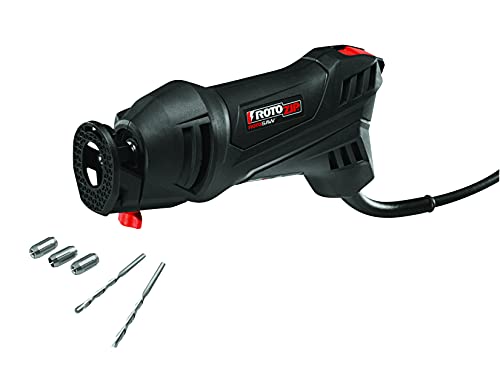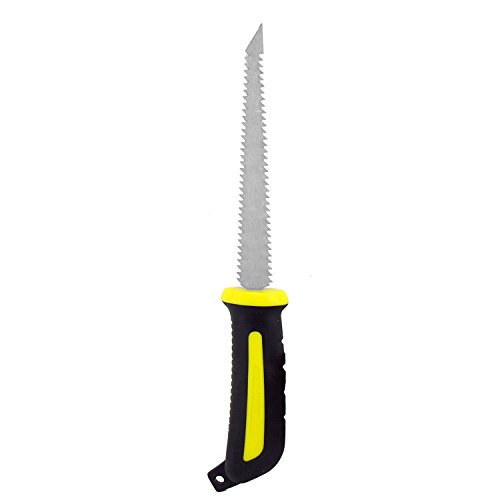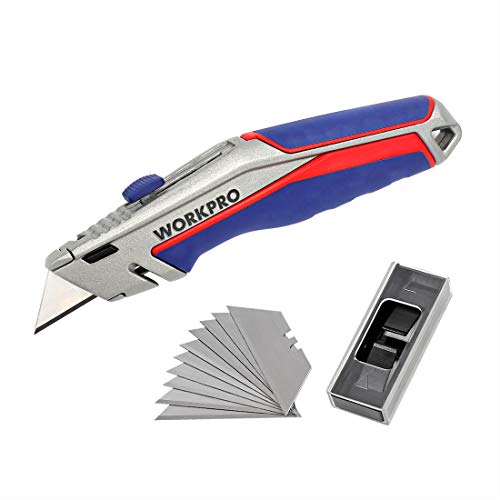Blind Mark Outlet System
Fast, easy to Cut Outlets
OUTLETS: BLIND MARK
IN THIS GUIDE:
› Drywall banjo: No products found.
› Mud pan kit: dewalt kit
› Drywall lift: diversified tools
› For fast cuts: original roto-zip
› Stilts: gyptools pro
› Tutorial: creative homeowner guide
Professionals know the best drywall tools will make a project go faster and improve results. But choosing the right tools for the various job phases requires understanding the basics of cutting, taping, and sanding.
And, for DIY’ers, the top drywall tools like stilts and mud hawks aren’t everyday purchases. But they are a must-have for most jobs.
From lifting to sanding, this guide will help you with the following:
- Cutting drywall
- Lift and hold sheets
- Screwing
- Taping and mudding
- Sanding
- And, most importantly, manage dust during the process
Lastly, if your budget doesn’t allow for a professional, then the other tool you’ll need is research and a mix of patience. While hanging drywall ideally takes time, a proper final coat is a skill.
Page Contents
Guide to the Best Drywall Tools
To help your project, though, we’ll take a look at tools in four categories:
- Cutting Tools – are different with the drywall as you’re cutting paper-coated gypsum and not wood (so put away your woodworking tools)
- Drywall Hanging – are tools to cut, lift and screw drywall to the wall.
- Finishing Tools – for taping, mudding, and sanding drywall.
- Dust Control – it’s essential to contain and manage drywall dust before it slips out of the workspace.
Best Tools to Cut Drywall
1. Rotozip Drywall Tool For Fast Cutting
See on Amazon: Rotozip SS-355
A rotozip will quickly trim drywall around windows, doors, outlets, and just about anywhere else.
If you install more than one drywall room, you’ll want a saw to trim outlets and windows quickly. Its high RPM blade will quickly cut drywall in any direction. Because it is an automated version of the drywall saw, you may not need both, but if I were buying one vs. the other, most professionals would opt for this handy saw.
And even better, with cordless options in almost all tools, you can consider dropping the cord (or not worrying about it on a job site).
2. Power Drywall Saw
See on Amazon: Makita Drywall Saw
Power drywall saws will make simple and complex drywall cuts and reduce the time spent cutting outlets and vent holes.
Firstly, they are very convenient as they don’t require a power outlet. They are also lightweight and easy to maneuver, making them perfect for cutting through drywall quickly and efficiently. Some models come with adjustable depth settings that help you make precise cuts.
Additionally, they have a dust collection system that keeps the work area clean and debris-free. All in all, cordless drywall saw is an excellent tool if you are a DIY enthusiast or a professional contractor.
3. Cut Drywall Holes And Outlines With A Jab Saw
See on Amazon: GreatNeck Jab Saw
The drywall saw is one of the simplest but most effective tools to cut drywall holes. With its wicked design and sharp teeth, it will melt thru drywall.
Since drywall is composed of compressed gypsum, it isn’t cut with standard wood-friendly tools. Instead, drywall is easy to cut with a sharp, aggressive blade design like the drywall saw that rips apart the gypsum as it goes.
What’s a drywall saw used for? A drywall saw is used to cut outlets, notches, and other rough-cut jobs in drywall. With large serrated teeth on one or both sides of its blade, it can quickly “poke” itself through a sheet of drywall and cut drywall to any shape with little effort.
4. Utility Knife to Cut and Score Drywall
See on Amazon: Workpro Utility Knife
That’s it; no saws are needed for rough sizing of drywall. Even if someone uses a circular saw on drywall, there are better ways to cut it.
5. Measure and Cut Using a T-Square
See on Amazon: Drywall T-Square
The T-square is combined with the utility knife for scoring drywall sheets.
This drywall tool serves the simple purpose of guiding a utility knife to cut a scoring line in drywall. Once the line is scored, the drywall is “broken” along the line with a forceful snap.
Tools to Lift, Hold and Screw Drywall
Here are some tools that can help you lift drywall:
1. Drywall lift – a tripod with a platform to hold the drywall sheet. You can adjust the platform height to match the ceiling height and then use the lift to raise the drywall sheet to the top.
2. Drywall hoist – a machine that can lift and move heavy drywall sheets. It’s beneficial if you’re working on large projects or need to move the drywall sheets to different room areas.
These tools can make lifting and installing drywall much more accessible and safer and can help you get better results in less time.
6. Drywall Jack to Support Overhead Sheets
See on Amazon: XINQIAO Jacks
A drywall jack will hold the drywall to the ceiling in jobs with or without a drywall lift. Due to their compact design, these will fit in areas a ride won’t (closets, etc.).
On smaller jobs or in tight spaces like closets where a drywall lift doesn’t make sense, going to a drywall jack will give you the extra hand you need. While this tool is widely used in cabinet installation as a jack, a few can also support the weight and height of drywall up to over 12′ ceilings.
With just a quick height adjustment with fine-tuning, you can adapt it from room to room to slide under the panel after it’s in place.
7. Drywall Pocket Kicker to Lift Bottom Sheets
See on Amazon: Drywall Kicker
8. Drywall Screw Gun For Fast Installation
See on Amazon: Dewalt Screw Gun
A collated screw gun is a must-have for a large job. Due to each sheet of drywall having dozens of screws, a manual method is possible, but it will slow you down.
First, though, each sheet of drywall will take dozens of screws that need to be set just below the surface of the drywall.
Because you’ll need some precision with the screw depth, you can use a standard cordless drill with a screw setting adapter for small jobs. But for big jobs, you’ll want a collated screw gun made for the job that has built-in screw depth control and the motor speed/drives setup for fast screw installation.
9. Drywall Tools to Lift Overhead
See on Amazon: Drywall Panel Lift – eleven feet
A drywall lift will take the heavy job of lifting drywall to the ceiling and holding it in place. And this drywall tool is necessary for any ceiling installation for strain and safety.
These lifts make putting a 4×12′ by 5/8″ thick sheet of drywall on the ceiling a cake. And they will also save your body a lot of pain and strain with their effortless ability to lift a 100-pound sheet of drywall to the ceiling and precisely hold it in place.
Should you buy or rent? Well, of all the tools on this list, it’s one tool for a homeowner you could reasonably buy, use, and re-sell as used at a cost lower than renting one.
Best Drywall Tools to Mud and Tape
When taping drywall, there are a few essential steps to remember.
First, you’ll want to ensure that the drywall is installed correctly and fully dry before taping. From there, you’ll want to apply joint compound to the seams between the pieces of drywall, using a putty knife to spread the mixture evenly.
Once the joint compound has been applied, you can use the tape, starting at one end of the seam and working your way to the other. Please press the drywall tape firmly into the joint compound to ensure it adheres properly. After applying the tape, you’ll need to apply a second coat of joint compound, using the putty knife to smooth out any bumps or ridges.
Finally, once the joint compound has dried, you can sand it down to create a smooth surface ready for painting or wallpapering.
10. Taping Knife and Mud Pans
See on Amazon: Dewalt Taping Tools
First, the best drywall tools for taping will all be stainless steel.
Since drywall mud contains water to stay flexible, it will rust any lesser-grade tools almost immediately.
And, the stainless steel aside, you’ll need a set of taping knives and a mud pan.
11. Drywall Stilts to Reach Ceilings
See on Amazon: Drywall Stilts
12. Drywall Banjo For Fast Joints
See on Amazon: Elko Banjo
A drywall banjo will quickly apply tape over the joints between sheets. The option to a banjo could be better (and involves manual methods), so of all the tools you’ll need to invest in, this is it.
Load the tape and mud into the machine and apply joint tape.
13. Drywall Sander For Final Sanding
See on Amazon: WEN 6377 Sander
One of the most challenging tasks in drywall is sanding drywall for a perfect finish WITHOUT a dust storm.
First, for all but the most seasoned professional, sanding is the make-or-break moment. Either the drywall will be perfect, and the paint won’t show your work – or the imperfections in hanging and mudding will shine through.
This is where a power sander that connects to your vacuum, contains dust, and quickly smooths your wall is an excellent investment in time and finished product quality.
Containing Drywall Dust
When it comes to home renovation projects, controlling drywall dust is a crucial aspect that must be addressed.
The dust produced during the installation and sanding of drywall can harm the lungs and overall health if inhaled. Therefore, it is essential to take necessary precautions to minimize the amount of dust that enters the air.
One way to do this is using a dust mask and protective gear while working. Covering furniture and floors with plastic or cloth can also prevent dust from settling on surfaces. Finally, using a vacuum with a HEPA filter can help to capture any remaining dust particles in the air. By taking these steps, you can ensure a safe and healthy environment while completing your renovation project.
14. Drywall Dust Wall Barriers
See on Amazon: Zipwall Dust Barrier
While a dust wall doesn’t stop the tools from generating dust, it does contain the dust from leaving the rooms you work in.
For that reason, dust walls can be built to extend from the floor to the ceiling and support plastic or cloth sheeting. Then, sometimes using magnetic doors, a barrier will form as a dust barrier.
I’d like you to please look for units that will work on smooth floors (typically come with a suction cup) to keep the wall firmly in place. That’s a common problem on slick, shiny concrete floors.
15. Drywall Dust Vacuum
See on Amazon: Stanley Dust Vaccum
While a dust barrier will contain the dust, the best option is not to let it escape your sanders. This is where DIY’ers can turn to a standard vacuum connected to tools or keep it on hand for quick dust cleanups.
Frequently Asked Questions
What is the best tool to cut drywall?
There are two best tools to cut drywall. First, a utility knife is a must for scoring sheet rock. And then, a jab saw is used to make cuts around outlets or doorways. While there are power saws and roto-zips, you can install most drywall jobs with these two essential tools.
What is the easiest way to cut drywall?
The easiest way to cut drywall is with a T-square and a utility knife. Simply scoring the face of the drywall with a utility knife can be cleanly “broken” and then the back trimmed to finish the cut. So that you know, no saws are required.
Is sheetrock the same as drywall?
Drywall is the generic name for gypsum board, while Sheetrock is a specific (and popular) brand name for drywall.
Summary
While you can install drywall without the right tools, having the best drywall tools for each aspect of the job is preferred. Not only will your installation go smoother, it will result in a higher-quality finish.
Lastly, while it’s up to your budget, checking the boxes on a drywall tools list will make for a better installation.
- About the Author
- Latest Posts
Eric has been a professional woodworker for over thirty years and has worked in small cabinet shops making everything from kitchen cabinets to hand-made furniture. Now working from a home woodworking shop Eric is sharing his passion for woodworking, tool advice and how-to knowledge from his Minnesota-based woodshop.














